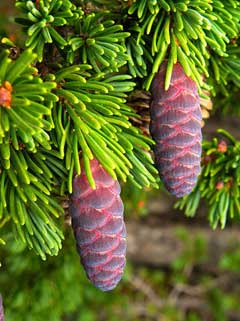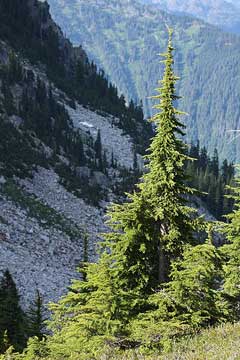 |
|
flickr.com/photos/28435100@N00 |
 |
| http://commons.wikimedia.org/wiki/User:Wsiegmund |
Translate this page:
Summary
Bloom Color: Green, Yellow. Main Bloom Time: Early spring, Late spring, Mid spring. Form: Pyramidal.
Physical Characteristics

 Tsuga mertensiana is an evergreen Tree growing to 45 m (147ft) by 10 m (32ft) at a medium rate.
Tsuga mertensiana is an evergreen Tree growing to 45 m (147ft) by 10 m (32ft) at a medium rate.
See above for USDA hardiness. It is hardy to UK zone 4. It is in leaf all year, in flower in April, and the seeds ripen from October to November. The species is monoecious (individual flowers are either male or female, but both sexes can be found on the same plant) and is pollinated by Wind.
Suitable for: light (sandy), medium (loamy) and heavy (clay) soils and prefers well-drained soil. Suitable pH: mildly acid, neutral and basic (mildly alkaline) soils and can grow in very acid soils.
It can grow in full shade (deep woodland) semi-shade (light woodland) or no shade. It prefers moist soil. It cannot tolerate atmospheric pollution.
UK Hardiness Map
US Hardiness Map
Synonyms
Plant Habitats
Woodland Garden Canopy; Hedge;
Edible Uses
Edible Parts: Inner bark Shoots
Edible Uses: Tea
Inner bark - raw or dried, ground into a powder and then used as a thickening in soups etc or mixed with cereals when making bread[161]. It is best used in the spring[172]. An emergency food, it is only used when all else fails[183]. A herbal tea is made from the young leaves and shoot tips[172, 183].
References More on Edible Uses
Medicinal Uses
Plants For A Future can not take any responsibility for any adverse effects from the use of plants. Always seek advice from a professional before using a plant medicinally.
Astringent Diaphoretic Diuretic Poultice
The bark is astringent, diaphoretic and diuretic[21]. A tea made from the inner bark or twigs is helpful in the treatment of influenza, colds, kidney or bladder problems, and also makes a good enema for treating diarrhoea[21, 257]. It can also be used as a gargle or mouthwash for mouth and throat problems or externally to wash sores and ulcers[21]. The powdered bark can be put into shoes for tender or sweaty feet or for foot odour[21]. A poultice of the chewed leaves has been used to treat burns[257]. The warm gum obtained from the trunks has been used as a dressing on cuts[257].
References More on Medicinal Uses
The Bookshop: Edible Plant Books
Our Latest books on Perennial Plants For Food Forests and Permaculture Gardens in paperback or digital formats.

Edible Tropical Plants
Food Forest Plants for Hotter Conditions: 250+ Plants For Tropical Food Forests & Permaculture Gardens.
More

Edible Temperate Plants
Plants for Your Food Forest: 500 Plants for Temperate Food Forests & Permaculture Gardens.
More

More Books
PFAF have eight books available in paperback and digital formats. Browse the shop for more information.
Shop Now
Other Uses
Dye Hedge Hedge Incense Pot-pourri Resin Tannin Wood
The slightly unripe cones are used in pot-pourri. They retain an attractive scent for several years[200]. Yields a resin similar to Abies balsamea, it is gathered by incisions in the trunk or by boiling the wood[46, 61, 64]. The bark contains 8 - 14% tannin[46, 171]. The inner bark is used according to one report[82]. A brown dye is obtained from the bark[21, 46]. The boughs are steamed or rubbed on furniture and used as a room deodorant and disinfectant[257]. A pitch (called hemlock pitch), is obtained by distillation of the young branches[46]. Tolerant of light trimming, plants can be grown as a tall hedge[29, 81]. Wood - strong[171]. Used for heavy construction[171]. Close-grained, light, soft and weak according to other reports, which go on to say that it is occasionally manufactured into lumber when other wood is not available[82, 229].
Special Uses
Hedge Hedge
References More on Other Uses
Cultivation details
Landscape Uses:Hedge, Aggressive surface roots possible, Screen, Specimen, Woodland garden. An easily grown plant, it thrives best when growing in a deep well-drained soil in the western parts of Britain where it appreciates the higher rainfall[11]. However, it succeeds in most soils and positions, being especially good on acidic sandy soils[81]. Plants are very shade tolerant when young, but need more sunlight as they grow older[81, 200]. Plants are thin and poor when grown in dry or exposed places[200]. Dislikes atmospheric pollution[82]. A very ornamental plant[11], it is slow growing for the first few years, averaging 30cm a year, but older trees, especially in Scottish lowland sites in areas with cool moist summers, are growing rapidly[185]. Trees live 400 - 500 years in the wild[229]. They commence bearing seeds when about 20 - 30 years old, years of high production alternating with years of low production[229]. Plants in this genus are notably resistant to honey fungus[200]. Special Features:North American native, Inconspicuous flowers or blooms.
References Carbon Farming Information and Carbon Sequestration Information
Temperature Converter
Type a value in the Celsius field to convert the value to Fahrenheit:
Fahrenheit:
The PFAF Bookshop
Plants For A Future have a number of books available in paperback and digital form. Book titles include Edible Plants, Edible Perennials, Edible Trees,Edible Shrubs, Woodland Gardening, and Temperate Food Forest Plants. Our new book is Food Forest Plants For Hotter Conditions (Tropical and Sub-Tropical).
Shop Now
Plant Propagation
Seed - it germinates better if given a short cold stratification[80, 113] and so is best sown in a cold frame in autumn to late winter. It can also be sown in early spring, though it might not germinate until after the next winter. If there is sufficient seed, an outdoor sowing can be made in spring[78]. Pot-grown seedlings are best potted up into individual pots once they are large enough to handle - grow them on in a cold frame and plant them out in early summer of the following year. Trees transplant well when they are up to 80cm tall, but they are best put in their final positions when they are about 30 - 45 cm or less tall, this is usually when they are about 5 - 8 years old[200]. Larger trees will check badly and hardly put on any growth for several years. This also badly affects root development and wind resistance[200].
Other Names
If available other names are mentioned here
Native Range
NORTHERN AMERICA: United States (Alaska (south), Idaho (north), Montana (northwest), Oregon, Washington, California (north & central), Nevada), Canada (British Columbia)
Weed Potential
Right plant wrong place. We are currently updating this section.
Please note that a plant may be invasive in one area but may not in your area so it's worth checking.
Conservation Status
IUCN Red List of Threatened Plants Status :

Growth: S = slow M = medium F = fast. Soil: L = light (sandy) M = medium H = heavy (clay). pH: A = acid N = neutral B = basic (alkaline). Shade: F = full shade S = semi-shade N = no shade. Moisture: D = dry M = Moist We = wet Wa = water.
Now available:
Food Forest Plants for Mediterranean Conditions
350+ Perennial Plants For Mediterranean and Drier Food Forests and Permaculture Gardens.
[Paperback and eBook]
This is the third in Plants For A Future's series of plant guides for food forests tailored to
specific climate zones. Following volumes on temperate and tropical ecosystems, this book focuses
on species suited to Mediterranean conditions—regions with hot, dry summers and cool, wet winters,
often facing the added challenge of climate change.
Read More
Expert comment
Author
(Bong.)Carrière.
Botanical References
1182200
Links / References
For a list of references used on this page please go here
Readers comment
| Add a comment |
|
If you have important information about this plant that may help other users please add a comment or link below. Only comments or links that are felt to be directly relevant to a plant will be included. If you think a comment/link or information contained on this page is inaccurate or misleading we would welcome your feedback at [email protected]. If you have questions about a plant please use the Forum on this website as we do not have the resources to answer questions ourselves.
* Please note: the comments by website users are not necessarily those held by PFAF and may give misleading or inaccurate information.
To leave a comment please Register or login here All comments need to be approved so will not appear immediately.
|
Subject : Tsuga mertensiana
|
|
|
|